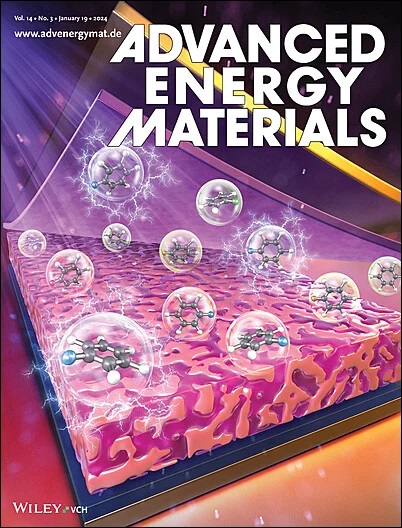Optimizing Conjugation of Polymer Hole Transport Materials via Cyclic Alkoxylation for Highly Efficient and Stable Perovskite Solar Cells
IF 24.4
1区 材料科学
Q1 CHEMISTRY, PHYSICAL
引用次数: 0
Abstract
Hole transport materials (HTMs) play a crucial role in realizing efficient perovskite solar cells (PSCs), as they improve perovskite affinity and passivation, charge transport and extraction, and ultimately the performance of PSCs. In this study, manipulating the conjugation extension in poly(triaryl amine) (PTAA) derivatives by cyclic alkoxylation of side benzene groups with benzo[d][1,3]dioxole (PTAAO5) and dihydrobenzo[b][1,4]dioxine (PTAAO6) is focused on. PTAAO6 exhibits extended π-conjugation within the side groups, leading to improved energy level alignment with perovskite and enhanced charge carrier transport compared to both PTAA and PTAAO5. This strong conjugation also promotes interactions between PTAAO6 and the perovskite, resulting in larger grain sizes with reduced defects within the perovskite layer. Therefore, PSCs incorporating PTAAO6 as the HTM achieve an outstanding power conversion efficiency of 25.19%, along with excellent operational stability, retaining 90.2% of the initial PCE after 1000 h under ISOS-L-3 testing conditions. These results underscore cyclic alkoxylation as a promising approach for tailoring polymer HTMs and provide crucial insights for designing high-performance PSCs.

求助全文
约1分钟内获得全文
求助全文
来源期刊

Advanced Energy Materials
CHEMISTRY, PHYSICAL-ENERGY & FUELS
CiteScore
41.90
自引率
4.00%
发文量
889
审稿时长
1.4 months
期刊介绍:
Established in 2011, Advanced Energy Materials is an international, interdisciplinary, English-language journal that focuses on materials used in energy harvesting, conversion, and storage. It is regarded as a top-quality journal alongside Advanced Materials, Advanced Functional Materials, and Small.
With a 2022 Impact Factor of 27.8, Advanced Energy Materials is considered a prime source for the best energy-related research. The journal covers a wide range of topics in energy-related research, including organic and inorganic photovoltaics, batteries and supercapacitors, fuel cells, hydrogen generation and storage, thermoelectrics, water splitting and photocatalysis, solar fuels and thermosolar power, magnetocalorics, and piezoelectronics.
The readership of Advanced Energy Materials includes materials scientists, chemists, physicists, and engineers in both academia and industry. The journal is indexed in various databases and collections, such as Advanced Technologies & Aerospace Database, FIZ Karlsruhe, INSPEC (IET), Science Citation Index Expanded, Technology Collection, and Web of Science, among others.
 求助内容:
求助内容: 应助结果提醒方式:
应助结果提醒方式:


